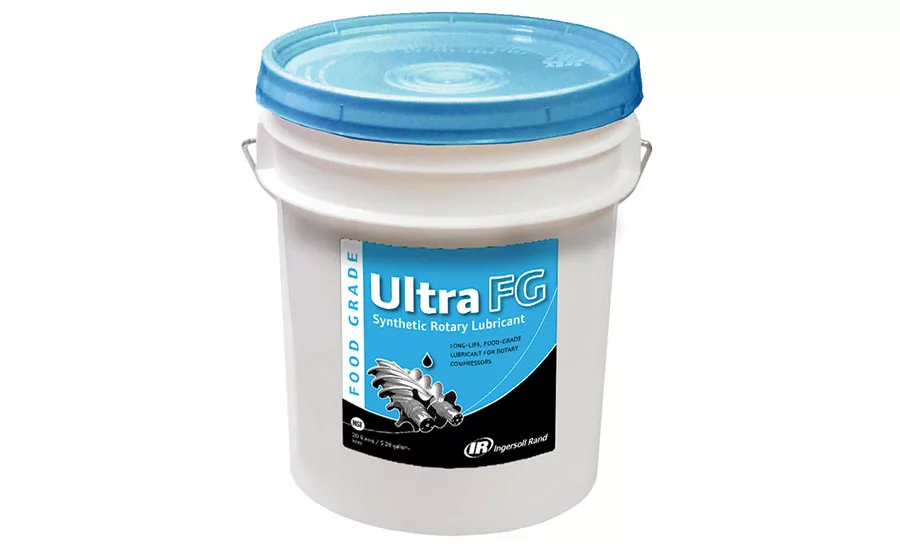Engineering R&D
Food-grade lubricants may require less frequent changes than previously thought
Give the maintenance staff a break and change the oil in air compressors less often

Chad Larrabee, services product management leader for Ingersoll Rand’s compression technologies and services.

Modern food-grade air compressor oils have been reformulated with a completely new base stock to have lifetimes exceeding 8,000 hours. Source: Ingersoll Rand.
It used to be that food-grade oil changes on your air compressors needed to be performed every 2,000 hours, and the oil in your car needed to be changed every 3,000 miles or three months—whichever came first. Sound familiar?
But lubricant chemistry has improved: Now, you might drive your car twice as many miles between oil changes. That’s not quite the same for food-grade air compressor lubricant applications. Since compressed air may have incidental contact with food or beverages, a food-grade lubricant (or H-1 lubricant) must be used in air compressors for applications anywhere in a food facility and, to qualify, must meet FDA Title 21 Code of Federal Regulations 178.3570 and be USDA/National Sanitation Foundation H-1 compliant.
What has changed is that the testing methods for food-grade lubricants have improved to predict and determine more accurately the actual lifetime of a compressor oil change—which may be better than previously expected.
Ingersoll Rand makes compressors for air and gas applications and provides services to keep the equipment up and running. The company also makes a food-grade lubricant to keep air compressors in food applications running smoothly. We asked Chad Larrabee, services product management leader for Ingersoll Rand’s compression technologies and services, to describe the evolution of food-grade lubricants for air compressors.
FE: A couple of years ago or so, you replaced your earlier X-tend lubricant with Ultra FG. What are the chemical differences between the two, and what was their expected lifetime at the release of Ultra FG?
Chad Larrabee: The X-tend 46 product was a 20-year-old technology using a poly alpha olefin [PAO]-based synthetic. The Ultra FG from Ingersoll Rand is a patented tri-synthetic lubricant using alkylated naphthalene as the base stock. The expected life was at least 6,000 hours at time of release, with expectations of an even longer life than that.
FE: What properties of a lubricant make it food grade?
Larrabee: A lubricant’s compliance with Title 21 Code of the Federal Regulations [CFR] and its certification as an H1-compliant lubricant through third-party validation make it food grade. The food-grade lubricant from Ingersoll Rand is registered with the National Sanitation Foundation [NSF], which is similar to the United States Department of Agriculture [USDA] H1, and is kosher/pareve and halal compliant, as well as free of any genetically modified organisms [GMOs] or typically specified allergens.
FE: What properties of a lubricant make it a good candidate for compressor applications?
Larrabee: There are the typical standard properties, which include correct viscosity, high viscosity index, good pour and flashpoints, hydrolysis, oxidative resistance, resistance to varnish, thermal stability and good thermal transfer properties. Along with all of those, it must also have the appropriate viscosity characteristics for the manufacturer-rated compressor operating temperature to ensure it has the correct fluid viscosity at typical operating parameters. There are several rigorous standard tests Ingersoll Rand conducts, which prove the validity of the lubricant life.
FE: For the chemists reading this, what specific changes were made to the formulation of FG to extend its lifetime beyond that of X-tend? How much longer was service initially with Ultra FG?
Larrabee: The Ultra FG was formulated with new, innovative patented chemistry for the food-grade industry. Ingersoll Rand didn’t look just to reformulate its current offering, but wanted to move to market with a unique, high-quality offering, which was achieved. As mentioned, it started with a complete change in base stock.
FE: What initial testing was done with Ultra FG to verify its longevity or maintenance interval?
Larrabee: Ingersoll Rand conducted a combination of lab-controlled environmental testing and American Society for Testing and Materials [ASTM] testing against our current offering at the time (the X-tend 46 food-grade product), as well as extensive real-world field testing at customer sites. Ingersoll Rand tested the product past 8,000 hours and regularly monitored the health of the product to ensure all major indicators [oxidative, total acid number, viscosity and additive levels] remained within our specified limits.
FE: You said additional testing has been done recently, which found a longer lifecycle or maintenance interval. What was this testing, and how much longer has FG been found to perform? Have changes been made to the chemistry?
Larrabee: Ingersoll Rand continuously monitors and reviews all the lubricant analyses submitted through the supplied program for both Ingersoll Rand-serviced and non-Ingersoll Rand-serviced assets, and documents the average operating hours between change outs. We have reviewed thousands of data points that show with properly maintained compressor systems, the Ingersoll Rand Ultra FG continuously exhibits life at or above 8,000 hours.
FE: Obviously, you’ve tested Ultra FG in conjunction with your compressors. What is your advice on using third-party lubricants?
Larrabee: We have evaluated most petroleum majors and compressor OEM products. We have found there is nothing like the Ultra FG globally, and no other product does a better job than Ultra FG in the food-grade arena. We have also found many other third-party suppliers recommend additional filtration components to achieve their rated life. Our Ultra FG can seamlessly go into the compressor, without the need for an additional in-stream filtration apparatus.
FE: Would you recommend your lubricant to be used with other makes of compressors? Why or why not?
Larrabee: Yes. I would recommend our product to be used in oil-flooded or oil-free rotary screw compressors from other manufacturers for the same reason it performs so well in our compressors. There is field data of the Ultra FG running in other-branded compressors, and the results aligned with what we see in Ingersoll Rand’s own compressors.
FE: What is the cost differential between Ultra FG and its predecessor, X-tend?
Larrabee: What is exciting about this longer-life lubricant is that the life is about four times [that of] its predecessor, but the cost is not four times as much.
FE: In what other applications in a food and beverage plant could this food-grade lubricant be used?
Larrabee: The formulation is specifically designed for use in oil-injected and oil-free rotary screw air compressors, but I would recommend the user verifies [its acceptability] with the manufacturer of their rotating equipment.
Food-grade lubricants must perform the same technical functions as any other lubricant, as well as resist degradation from food products, chemicals and water/steam.
They must exhibit neutral behavior toward plastics and elastomers, have the ability to dissolve sugars and be physiologically inert, tasteless and odorless.
Looking for a reprint of this article?
From high-res PDFs to custom plaques, order your copy today!







